By Peter J. Nash
July 24, 2014
 |
When the authenticity of Babe Ruth’s alleged 1923 World Series pocket watch and a bogus letter attributed to 19th century HOFer John M. Ward were questioned earlier this year, Heritage Auctions sports director, Chris Ivy, told Hauls of Shame, “Heritage would never sell an item which we do not believe to be genuine.”
But despite Ivy’s emphatic claim, Heritage Auction Galleries in Dallas, Texas, is offering more fakes and frauds in its Platinum Night Auction scheduled for July 31st at The House of Blues in Cleveland in conjunction with the National Sports Collectors Convention. Ivy recently raised some eyebrows when a Heritage press release was picked up by the Associated Press and ESPN advertising the upcoming sale of an alleged Lou Gehrig signed ticket from “Gehrig Day” in 1939 that he calls “the most significant baseball ticket in the world.” The AP reports that the ticket is “estimated to bring over $100,000″ at the live event in Cleveland. Several experts and hobby observers, however, think that the Gehrig signature on the ticket is not genuine, but even more disturbing is another Heritage lot in the glitzy auction catalog that has been identified as a counterfeit 1882 Cincinnati Reds presentational pocket watch attributed to 19th-century star Charlie Gould. The auction house estimates the timepiece could sell for over $60,000 but the alleged 1882 Reds championship watch is actually a well-documented fake created by early 1990’s forger Randy Lee Marshall.
Marshall, a former batboy for the Reds, was convicted in 1993 for mail and wire fraud and was sentenced to twenty one months in prison as a result of an FBI investigation. Marshall identified the watch currently being offered by Heritage on his own personal “Top 10 Forgeries” list which was published in Cincinnati Magazine in 1995 (the article incorrectly identified the watch as being dated 1888). In addition to peddling that historic fake, Heritage is also continuing its unfettered sales of stolen documents from the National Baseball Hall of Fame in Cooperstown with the offering of a 1923 letter written by Christy Mathewson protesting a game between the Boston Braves and Brooklyn Dodgers in 1923. The National Baseball Library’s files house the August Herrmann Papers collection which includes letters and affidavits for protested games in the National League spanning from 1902 to 1926.
Chris Ivy’s inclusion of the counterfeit Charlie Gould watch in the current Heritage sale is stunning considering the pocket watch had been identified in public records as a forgery several years after it was sold in 1991 at Richard Wolfers Auctions. The watch appeared in a sale conducted by Democratic Party fundraiser Duane Garrett who had also sold other fakes created by Randy Marshall including Harry Wright’s boots, Babe Ruth’s St. Mary’s Industrial School uniform and a pocket watch allegedly presented to President William Howard Taft. All of the items came with forged documents alleging provenance from government officials and Major League owners. Like Heritage’s Gould watch, the Wolfers lot description said the phony Harry Wright boots were:
“Accompanied by extensive documentation including a copy of a 1952 letter from U. S. Senator Robert A. Taft to Clark Griffith loaning these boots (which were the treasured property of the Fleischman family of Cincinnati) to an exhibition and a letter from the Hall of Fame that states in part “As you know these fabulous artifacts are some of the earliest known examples of the Red Stockings and the birth of baseball”. Of the highest order of importance and rarity.”
Wolfers estimated the value at $15,000-17,500 and the boots ended up selling for $3,300. The Wright boots were again recently identified as fakes in a post published by researcher Jimmy Leiderman at The New York Clipper in 2012. The Taft watch, said to be presented to the President at the dedication of Redland Field in 1912, includes similar forged documents including a 1952 letter from Senator Taft to Clark Griffith.
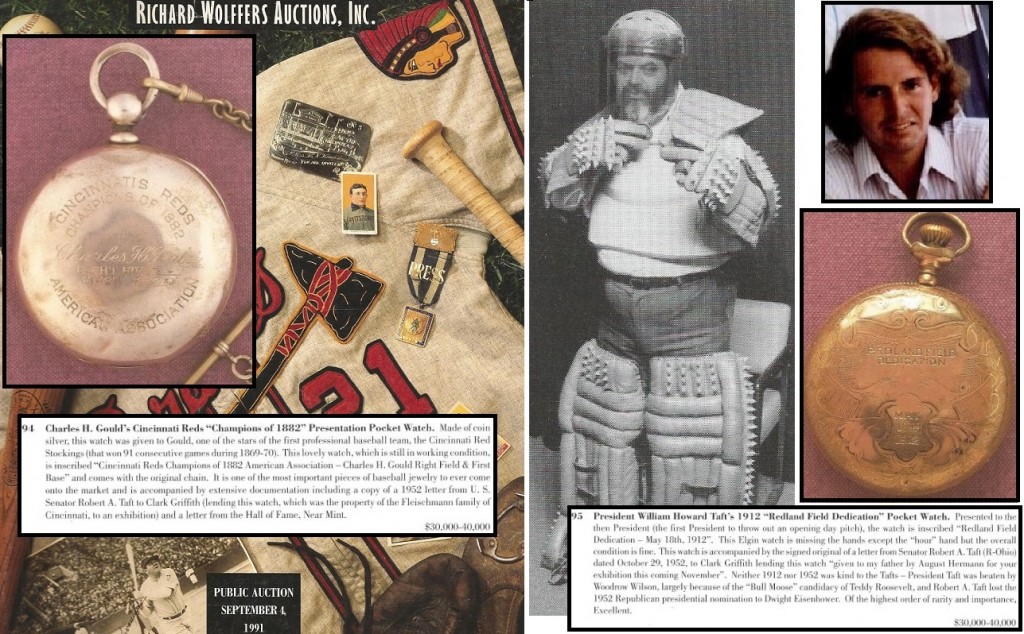
Duane Garrett (center) offered the bogus 1882 Reds watch for sale in his 1991 "Treasures of The Game" auction at Richard Wolfers in San Francisco. The watch had the same alleged provenance as another counterfeit watch attributed to President William Howard Taft. Both watches were created by convicted forger Randall Lee Marshall (inset top right).
Ivy and Heritage estimate the value of the bogus watch at “$60,000 and up” and state in the current lot description:
“The watch first entered the collecting hobby in a 1991 auction, when it was accompanied by an impressive folder of letters detailing its provenance. While the originals have since been lost, photocopies remain, including: 1) 1952 letter from US Senator Robert Taft to Washington Senators owner Clark Griffith lending the watch for display. 2) 1981 letter from Hall of Fame pitcher Waite Hoyt to an unknown recipient (presumably Taft or his family) thanking him for allowing the watch to be displayed at a restaurant. 3) 1986 letter from Baseball Hall of Fame President Edward Stack to the same unknown recipient requesting donation of the watch for the museum’s permanent display.”
The Heritage lot description describes the Gould watch as a “special award” presented to Gould after the Reds won the American Association championship in 1882. Although Gould had no apparent affiliation with the Reds in 1882, Heritage states without any supporting evidence, “Some form of coaching role is the most likely association.” When Wolfers sold the watch they described it as “one of the most important pieces of baseball jewelry ever to come onto the market.”
Similar to other questionable lots sold by Ivy and Heritage in the past, the auction house does not post any of the alleged letters of provenance with the Gould watch. After his conviction, Marshall admitted he had forged all of the additional documentation that supported the authenticity of his creations. In a 1995 article published in The Boston Globe Marshall was quoted as saying, “Some of my items are in the Smithsonian, some are in the Cooperstown Hall of Fame….Even now, I look at catalogs from Christie’s and Sotheby’s and I still see my pieces.” In the 1995 Cincinnati Magazine feature article called “The Forger” Marshall identified his own work in a Wolfers catalog and said, “That’s mine,” when he spotted a c.1900 Honus Wagner jersey he had created by adding the chain-stitched “Wagner” name to a period Spalding flannel. Wolfers valued the fake at “$175,000-$200,000.”
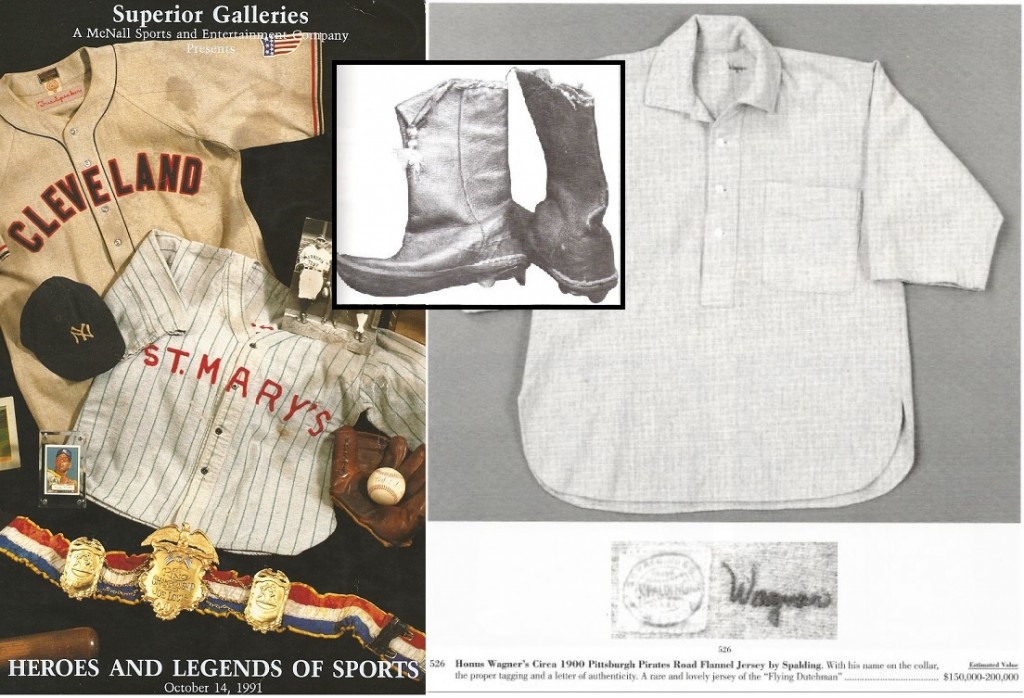
Randy Marshall's forgeries ended up in major auctions including: Babe Ruth's St. Mary's jersey (left) which appeared on the cover of both Superior and Wolfers catalogs in 1991; Harry Wright's boots (inset) in Wolfers; and Honus Wagner's c.1900 jersey at Wolfers in 1995 (right).
At the time Marshall’s forgeries were circulating in the hobby, current Heritage consignment directors Mark Jordan and Mike Gutierrez were working for Wolfers and Duane Garrett as consignment agents and authenticators. After the bogus Babe Ruth St. Mary’s uniform failed to sell at Wolfers in 1991 it resurfaced in two later sales held by Superior Auctions in Beverly Hills in 1992 and 1993 when Gutierrez was working exclusively for LA Kings owner Bruce McNall as Superior’s baseball consultant. By the time Randy Marshall was convicted and his creations were identified in the press, Mark Jordan had already authenticated hundreds of thousands of dollars of other forged items that had appeared in Wolfers sales. After this writer and several other experts and hobbyists illustrated how many forgeries were appearing in the Wolfers auction catalogs the once prominent auction house lost credibility and faced further scrutiny which led to auction founder Duane Garrett’s alleged suicide jump off the Golden Gate Bridge.

Ex-Cincinnati Reds batboy Randy Lee Marshall was convicted after an FBI investigation that included his admission that he created an engraved pocket watch presented to Charlie Gould. The watch appears on a "Top 10" list of Marshall's forgeries published in Cincinnati Magazine in 1995 (right).
According to Cincinnati Magazine, Marshall also used the alias, Geoff Wayne, and created scores of forgeries that made their way into other major auctions as well as exhibits at the Babe Ruth Museum in Baltimore, Maryland. There were also talks of one of Marshall’s Ruth fakes even landing in a display case at the FBI office in Minneapolis. Marshall created other relics ranging from Yankee pitcher Waite Hoyt’s 1927 World Series ring to a silver bat he crafted as Lou Gehrig’s 1936 MVP award which he called his “finest” work. Heritage is currently offering another 1927 Yankee World Series ring attributed to Earle Combs, but that ring appears to be authentic and originates from Combs’ grandson. Marshall also ventured into football items and created a 1972 Dallas Cowboys Super Bowl trophy. The current Heritage sale includes two misrepresented Pittsburgh Steeler Super Bowl rings that have been doctored with unofficial engraving and appear to be salesman’s samples.
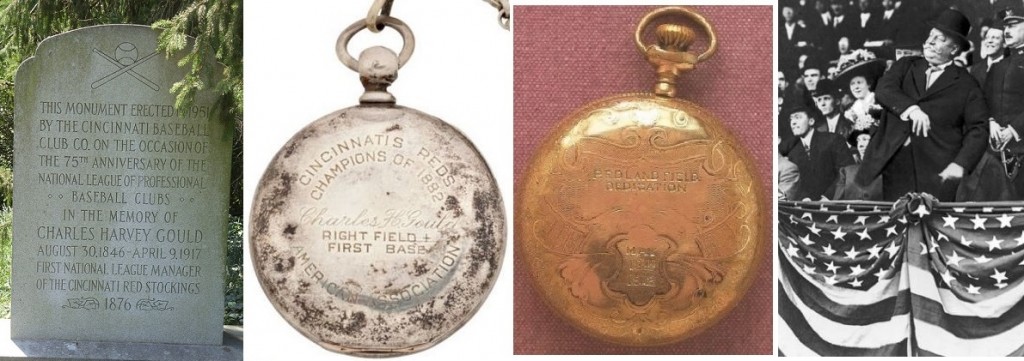
The Reds erected a monument above Charlie Gould's grave in 1951 and forger Randy Marshall created a fake watch allegedly honoring him in 1882. Marshall also created a bogus watch he said was presented to President Taft at the dedication of Redland Field in 1912.
The evidence that Heritage’s 1882 Reds watch is a fake is so overwhelming one has to question what type of due diligence Chris Ivy, Mike Gutierrez, Mark Jordan, Rob Rosen and Kevin Grady conduct when it comes to vetting major items appearing in HA sales. Hauls of Shame has identified other alleged fakes that Heritage has offered including the “last out ball” from the 1917 World Series. The auction house removed that ball from a 2012 sale when our report illustrated that the ball wasn’t manufactured until 1926. More recently, Heritage proceeded with the sale of a bogus document said to bear the rare autograph of HOFer John M. Ward, despite the fact that Hauls of Shame and other experts definitively identified the Ward autograph as an obvious secretarial signature.
Randy Marshall, who currently lives in Saint Augustine, Florida, and operates an online collectibles store called “Dead Peoples Things” did not respond to our request for comment.

The Lou Gehrig signed ticket in the current HA sale (right) has been identified as a forgery by experts and is similar in construction to two other single-signed Gehrig balls sold at HA and Mastro Auctions (left).
In 2012, Heritage offered a single-signed Lou Gehrig baseball that several experts, including author Ron Keurajian, opined was a forgery. The ball was signed on an official American League ball believed to have been manufactured in 1940 when Gehrig could not have signed the ball due to his physical condition. Heritage removed the ball from the sale as a result of our report but later returned the same ball to a 2013 auction after they uncovered evidence suggesting that it was possible for Gehrig to have signed that particular type of AL baseball in late 1939. But even if Gehrig could have signed the ball sometime in 1939, that fact appears irrelevant based upon the opinions that the Gehrig signature on the ball is not genuine. The signature on the Heritage ball and the signature on the ticket currently being offered for sale are both inconsistent with other verifiable authentic signatures executed by Gehrig during the same period during 1939.

Authentic Lou Gehrig signatures executed in the summer of 1939 contrast the alleged Gehrig signature on the ticket being offered by Heritage (bottom in red). The genuine Gehrig signatures appear clockwise from top left: 1. July 16, 1939 letter; 2. June 20, 1939 check to Mayo clinic; 3. Letter to Doctor from September, 1939; 4. Letter from July 7, 1939; 5. Letter from 1939 on PSA "Autograph Facts" page.
The “Gehrig-Day” ticket signature appears to have been executed with considerable hesitation and stoppages causing uneven ink flow and awkward letter construction, which are all tell-tale signs of forgery. The ticket also features several sections of paper loss which have obscured parts of the signature and appear may have been done intentionally to remove other mistakes made in the execution of the forgery.
One expert told us that the signature on the ticket looks as if someone used other Gehrig forgeries signed on baseballs as an exemplar. While PSA/DNA and Steve Grad have authenticated the ticket and encapsulated it in a plastic holder, anyone with a background in handwriting analysis can identify the numerous differences between the Heritage signature and genuine Gehrig handwriting samples from the same time period.
While Heritage appears to be offering bogus Gehrig autographs on a regular basis, they are also pushing forward with their steady flow of documents believed to have been stolen from the National Baseball Library in Cooperstown. This time Ivy and Co. are offering a 1923 letter written by Boston executive Christy Mathewson to NL President John Heydler protesting a home run call in a game played against the Dodgers on July 4, 1923.
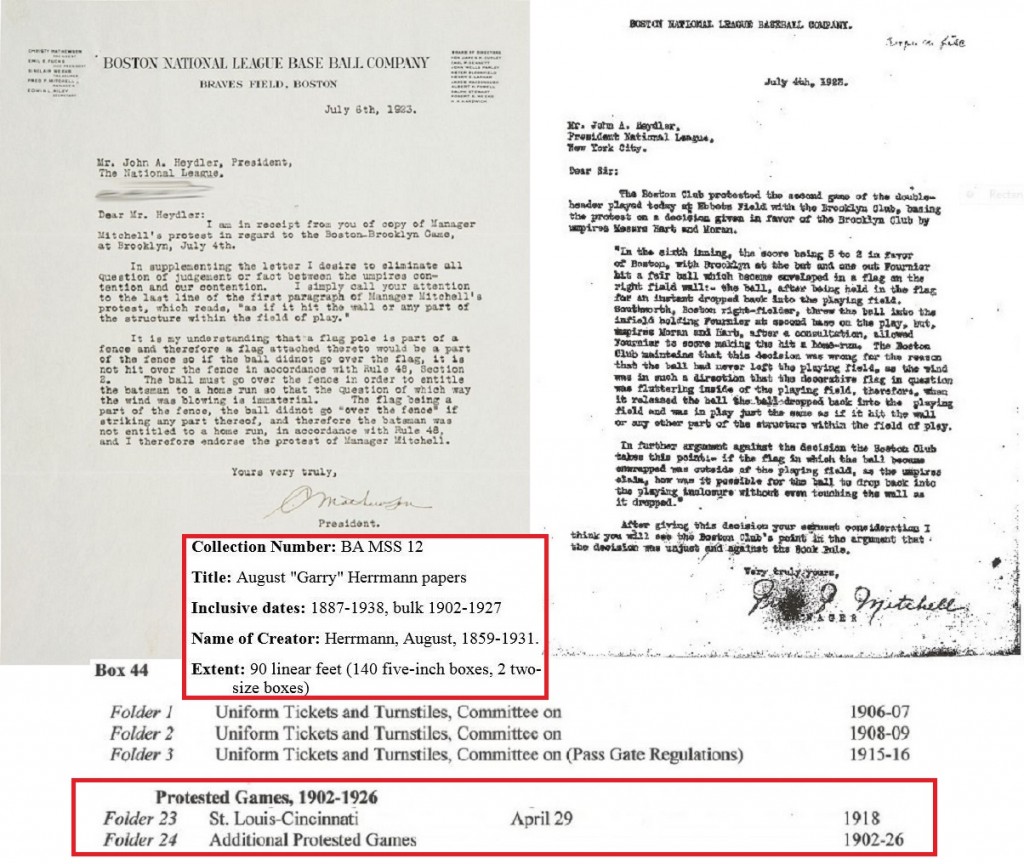
The 1923 Matty protest letter being offered by HA (left) is missing from the HOF's "Herrmann Papers" file "Folder 24" from "Box 44" which still retains an affidavit signed by Brave Fred Mitchell protesting the exact same game against the Brooklyn Dodgers.
The Mathewson letter which has an estimated value of “$15,000 and up” appears as lot 80059 and is just one of several documents originally housed in the Hall’s August Herrmann Papers donated in 1961 by Reds owner Powell Crosley Jr. The same Hall of Fame files still retain the letter initially protesting the game penned by Boston Brave manager Fred Mitchell sent to Heydler on July 4, 1923, and describing the same disputed home run that Mathewson documents in the July 6th letter being offered by Heritage.
Mathewson’s missive references Mitchell’s letter stating, “I am in receipt from you (a) copy of Manager Mitchell’s protest in regard to the Boston-Brooklyn Game at Brooklyn, July 4th.” How could the Matty letter addressed to the National League and referencing the same letter still found in the HOF files end up in private hands and a Heritage sale? It’s the same question that’s been asked about Chris Ivy’s inclusion of other letters originating from the Herrmann files written by Honus Wagner and Barney Dreyfus that appeared in Heritage’s last sale. Those letters join other alleged stolen documents offered by Heritage in the past including examples written by Babe Ruth and the 1915 Red Sox team, Charles Comiskey, Fred Clarke, Joe Tinker, AL President Ban Johnson, and Ed Barrow. Two others originating from the Hall were written by Miller Huggins and Hank O’Day and were sold recently at Heritage by autograph dealer Jack Smalling who claims the two letters were given to him in the 1960’s as a gift from Hall of Fame historian Lee Allen. Allen, however, had no authority to gift the documents to Smalling at the time since the documents had become the property of New York State after they were donated.
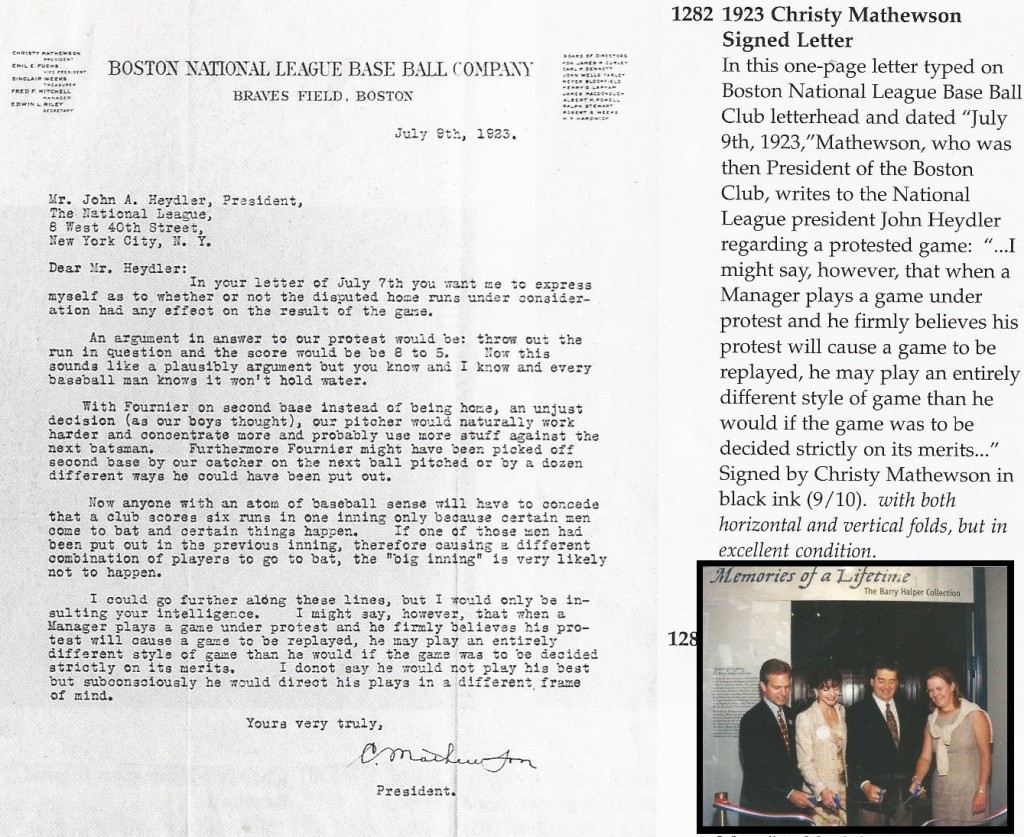
Another Mathewson protest letter believed to have been stolen from the Hall of Fame appeared as part of the Barry Halper Collection at Sotheby's in 1999. Halper and Jane Forbes Clark (inset) cut the ribbon for the grand opening of the Hall's "Halper Gallery" in 1999. The gallery dedicated in Halper's honor no longer exists.
Another Mathewson letter from the same Herrmann Papers file and regarding the same protested game of July 4, 1923, appeared for sale as part of the Barry Halper Collection at Sotheby’s in 1999. Halper and his hand-picked consultant, Rob Lifson, included in the sale a large group of items stolen from the New York Public Library, Boston Public Library, Hillerich & Bradsby Co. and the Baseball Hall of Fame. All of the stolen documents were authenticated for Sotheby’s by current Heritage consignment director Mike Gutierrez.
One of the first public sales of a letter addressed to August Herrmann at auction occurred in May of 1991 at Richard Wolfers when Gutierrez was listed in the company’s catalog as an “auction agent” along with current Heritage employee Mark Jordan. Sources indicate that a 1926 letter written to Herrmann by John C. Hendricks regarding “being swindled by John McGraw,” was secured for auction by Gutierrez as one of Duane Garrett’s agents. File folder 19 from box 24 of the Hall of Fame’s Herrmann archive includes correspondence between Hendricks and Herrmann between 1924 to 1926 when Hendricks was the Reds manager. The letter appeared in a Wolfers catalog that advertised the September 1991 “Treasures” auction that would feature the very same bogus 1882 watch that is now appearing for sale next week at the National in Cleveland along with the stolen Mathewson letter.

The May 1991 Wolfers catalog lists as "auction agents" current Heritage employees Mark Jordan and Mike Gutierrez. That sale featured one of the first public sales of an August Herrmann letter sourced to Gutierrez (inset).
Gutierrez was also familiar with the Herrmann material having authenticated other National League protest documents for Sotheby’s in 1999 including letters by the likes of HOFers Fred Clarke, John J. McGraw, Bill Klem, Joe Tinker, John Evers and Mathewson. Other letters stolen from the Hall and sold by Halper at Sotheby’s originated from Ford Frick’s file of thank you letters from players who received lifetime passes including Jesse Burkett, George Wright, Sliding Billy Hamilton and Jimmy Collins.
Back in the late 1980s, Gutierrez became the prime suspect in an FBI investigation into the Hall of Fame thefts after he sold a stolen Babe Ruth photo to New York auctioneer Josh Evans and was further implicated after a man who accompanied him on a trip to the Hall of Fame library told investigators he saw Gutierrez stealing documents from the Herrmann archive and placing them in his brief case. Less than two years after that accusation, Herrmann documents began surfacing in auction sales conducted by Wolfers and Superior at a time when Gutierrez was affiliated with both companies.
Fearing backlash from current and future donors, Hall of Fame officials failed to press charges and pursue recovery and since that time the institution has failed to claim title to any of the stolen documents that have surfaced in the marketplace, mostly via sales at Heritage. Several reports of the thefts have recently been filed at the local Cooperstown Police Department but without the Hall’s own filings and cooperation, police officials can do little to recover the stolen property. Hall of Fame officials including PR rep Brad Horn and President Jeff Idelson did not respond to requests for comment on the current Mathewson offering at Heritage.
Heritage’s Sports Director, Chris Ivy, has told Hauls of Shame on numerous occasions that unless the Hall of Fame claims title to the stolen Herrmann letters they are offering for sale, the auction house will not withdraw the lot and will proceed with the sales to the general public.